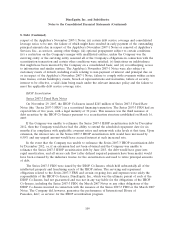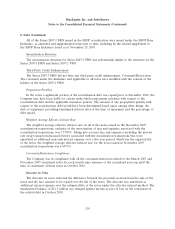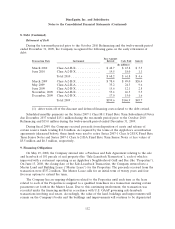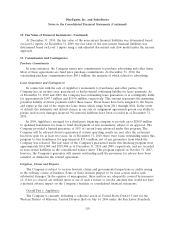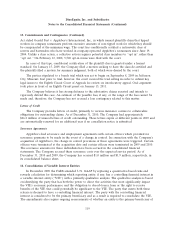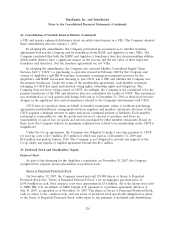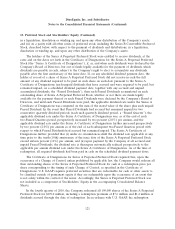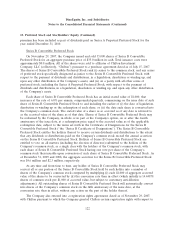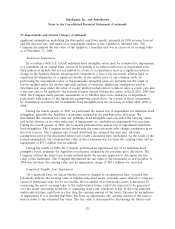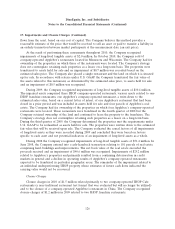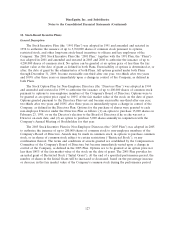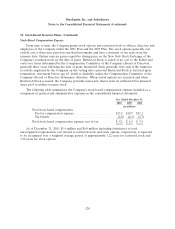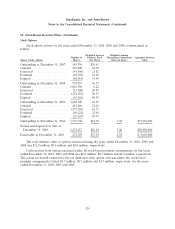IHOP 2010 Annual Report Download - page 135
Download and view the complete annual report
Please find page 135 of the 2010 IHOP annual report below. You can navigate through the pages in the report by either clicking on the pages listed below, or by using the keyword search tool below to find specific information within the annual report.DineEquity, Inc. and Subsidiaries
Notes to the Consolidated Financial Statements (Continued)
13. Commitments and Contingencies (Continued)
Act styled Gerald Fast v. Applebee’s International, Inc., in which named plaintiffs claim that tipped
workers in company restaurants perform excessive amounts of non-tipped work for which they should
be compensated at the minimum wage. The court has conditionally certified a nationwide class of
servers and bartenders who have worked in company-operated Applebee’s restaurants since June 19,
2004. Unlike a class action, a collective action requires potential class members to ‘‘opt in’’ rather than
‘‘opt out.’’ On February 12, 2008, 5,540 opt-in forms were filed with the court.
In cases of this type, conditional certification of the plaintiff class is granted under a lenient
standard. On January 15, 2009, the Company filed a motion seeking to have the class de-certified and
the plaintiffs filed a motion for summary judgment, both of which were denied by the court.
The parties stipulated to a bench trial which was set to begin on September 8, 2009 in Jefferson
City, Missouri. Just prior to trial, however, the court vacated the trial setting in order to submit key
legal issues to the Eighth Circuit Court of Appeals for review on interlocutory appeal. Oral argument
took place in front of an Eighth Circuit panel on January 13, 2011.
The Company believes it has strong defenses to the substantive claims asserted and intends to
vigorously defend this case. An estimate of the possible loss, if any, or the range of the loss cannot be
made and, therefore, the Company has not accrued a loss contingency related to this matter.
Letters of Credit
The Company provides letters of credit, primarily to various insurance carriers to collateralize
obligations for outstanding claims. As of December 31, 2010, The Company had approximately
$26.2 million of unused letters of credit outstanding. These letters expire at different points in 2010 and
are automatically renewed for an additional year if no cancellation notice is submitted.
Severance Agreements
Applebee’s had severance and employment agreements with certain officers which provided for
severance payments to be made in the event of a change in control. In connection with the Company’s
acquisition of Applebee’s, the change in control provisions of these agreements were triggered. Certain
officers were terminated at the acquisition date and certain officers were terminated in 2009 and 2010.
The severance amounts for these individuals have been accrued in the consolidated financial
statements. The Company accrued these severance costs over the expected service period. As of
December 31, 2010 and 2009, the Company has accrued $1.0 million and $1.9 million, respectively, in
its consolidated balance sheet.
14. Consolidation of Variable Interest Entities
In December 2009 the FASB amended U.S. GAAP by replacing a quantitative-based risks and
rewards calculation for determining which reporting entity, if any, has a controlling financial interest in
a variable interest entity (‘‘VIE’’) with a primarily qualitative analysis. The qualitative analysis is based
on identifying the party that has both the power to direct the activities that most significantly impact
the VIE’s economic performance and the obligation to absorb losses from or the right to receive
benefits of the VIE that could potentially be significant to the VIE. The party that meets both these
criteria is deemed to have a controlling financial interest. The party with the controlling financial
interest is considered to be the primary beneficiary and as a result is required to consolidate the VIE.
The amendments also require ongoing reassessments of whether an entity is the primary beneficiary of
119


